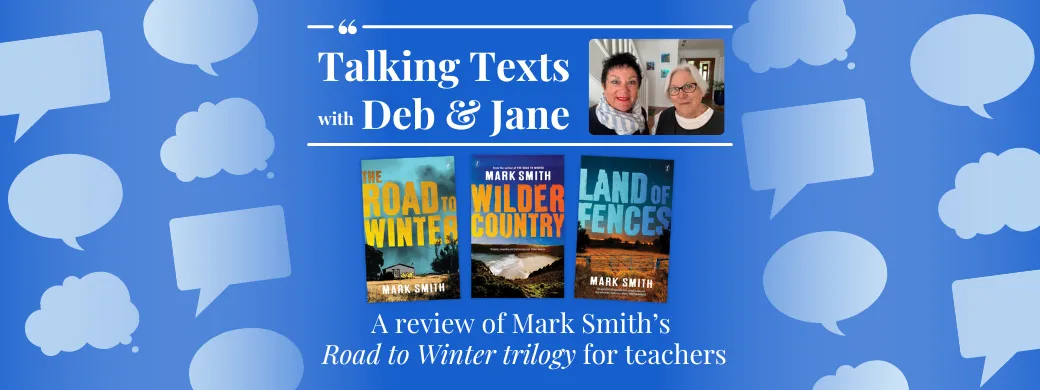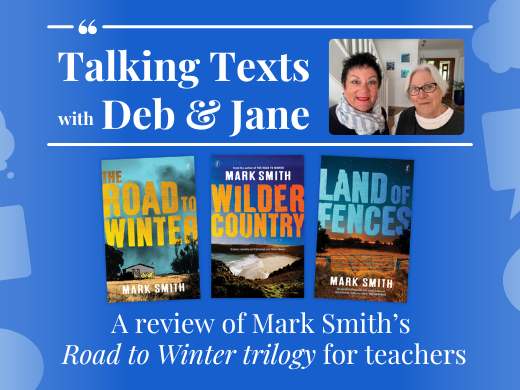

Flat Rate Shipping
$7.95 flat rate shipping or free over $120


Aussie Owned
Australian family-owned & sourced


School Supplier
Supplier to over 1,000 schools Australia wide


For Stages 5 and 6
Dystopian fiction has been a feature of 21st century Young Adult fiction and The Road to Winter trilogy will have very strong appeal for students in Years 9, 10 and 11 as it considers so many of the issues young people are concerned about including justice and discrimination, mental health and the environment. Written before the COVID 19 pandemic, these three novels provide a vivid description of the aftermath of an even more virulent virus. Please note the syllabus references in this blog are to the NSW 7-10 English Syllabus (2022). The new Stage 6 English Syllabus is due to be released later in 2024.
While set in a dystopian future in Australia The Road to Winter begins with a great surfing scene. Sixteen-year-old Finn is alone, except for his dog, Rowdy, on the outskirts of Angowrie, a small coastal town. A virus has wiped out most of the population and his mother’s bravery in sending him away from her before he got infected has saved his life. Finn’s speech impediment made him something of a loner, even before the virus, and he has developed survival skills that serve him well. He leads a solitary life, only punctuated by occasional contact with Ray, an older survivor. Finn is careful, cautious, and it turns out, courageous.
It is after surfing that Finn sees someone on the beach. Rose is a Siley, an asylum seeker. She has not been treated well in Australia; Rose and her sister Kas were used first as indentured labourers, then they become slaves. They have escaped the Wilders, a savage group of survivors who terrorise others. But the sisters have been split up and Ramage, the Wilders’ leader, is hunting them both down. It seems Ramage has a special desire to recapture Rose. Finn recognises that while survival is vital it is not sufficient. Rose is wounded and Finn helps her and aids her efforts to reconnect with her sister. As the Wilders close in, and decisions become knife-edged, the humanity and resilience of Finn and Rose prove a powerful connection.
There are no special powers or fantastic escapes in this novel. An infected wound is deadly and there are no easy answers. It echoes McCarthy’s The Road more than Marsden’s Tomorrow When the War Began. It deals with rape and childbirth as well as survival and the treatment of refugees.
At the start of the second book in the series, Wilder Country, Finn is surfing, letting the water give respite from remembering what happened during winter. Rose has died and her baby Hope has been stolen by the Wilders. Kaz has withdrawn into herself and young Willow is learning how to trap for food. But Kas and Finn have vowed to rescue the baby and as the storms of winter subside, spring is time to go looking. Of course, the Wilders will be looking for them as well. Author Mark Smith knows just how to ratchet up the tension and there will be no escaping conflict as the search takes them deeper into dangerous territory. Wilder Country is another compulsive page turner and the reader watches as Finn does battle not just with the Wilders but with himself. He has let Rampage off once when he could have killed him, troubled by the very act of killing. When faced with killing to survive Kaz has no such compunction. There is occasional respite to be found amid the growing tender attachment between Kaz and Finn and the vivid descriptions of the country, but the ethical dilemmas keep piling up and there is no real letup in the battle to survive.
The concluding novel in the Road to Winter trilogy, Land of Fences, is a very satisfying one. Finn and Kas are back on the coast at Angowrie with old timer, Ray, making and enjoying a life together. Surfing and swimming are entwined with food gathering but there is still unease and anxiety in their lives. At the end of Wilder Country, the lights in the nearby town of Wentworth came on and Kas, as an escaped Siley or enslaved asylum seeker, is worried that her tracker, implanted in her skin will be re-activated and the Wilders will be coming for her again. She is right to be worried as the new authorities empower the murderous Wilders leader, Ben Rampage, as the Southwest Region Commissioner. Joined by other resisters, JT and Daymu, and dog Rowdy, Kas and Finn take off once again. When Kas and Daymu are captured Finn, with some unexpected help, must find a way to rescue them.
Danger and menace are inescapable in this future Australia where a virus has sent people back into survivor mode yet Finn recoils from gratuitous violence and earns the reader’s admiration for his courage as he moves to free his friends, despite fear and deprivation. The book bursts into action and suspense and all three books will be an asset in the classroom in attracting a variety of readers from Years 9-11. This trilogy charts a plausible yet terrifying future Australia in compelling tones and the resistance and resilience of Finn, the central character of the trilogy should have particular appeal for boys.
Wilder Country was the Winner of the 2018, Indie Book Award for Young Adult.
Students are drawn to the dystopian genre as they are understandably interested in what the world could be like in their future. Literature can certainly help in that exploration and The Road to Winter trilogy would provide an excellent starting point in a genre study.
Encouraging students to read and view widely in this genre can have very positive results. Posing tasks such as “write/create a description of a better tomorrow in any medium” can enable them to use the texts they have read and viewed as research points to compose a description of a future world that is better than the one, they currently inhabit.
Teachers interested in constructing a wide reading unit could access Electric Lit Dystopian fiction which contains a brief history which could be used as an introduction to such a unit.
Post-apocalyptic novels are popular with young adults. Teachers in Year 11 could consider novels like John Lanchester’s The Wall, Cormac McCarthy’s The Road, and M T Anderson’s Feed which portray societies that no longer care or act responsibly to sustain their environments. The film Blade Runner, directed by Ridley Scott, is a film noir set in a bleak future where power is held by a few wealthy companies, the environment is barren and ‘replicant’ humans are exploited. Lilli Wilkinson’s After the Lights Go Out explores the effects of climate change and an epidemic on a future Australia.
One distressing conversation between Finn and Rose in The Road to Winter certainly captures the reader’s attention:
‘What’s wrong with people in this country, Finn? Even before the virus it was so beautiful here; you had everything. But you were so cruel.’ (p.198)
Students could consider how Smith positions the reader in the three novels to view the treatment of refugees by looking at characterisation, perspective and the context of their mistreatment and compare it to the ways the media portrays the position of refugees today.
Please note these references below are to the NSW English 7-10 Syllabus. The new NSW English Stage 6 Syllabus is due for release some time in 2024.
Text requirements: The Road to Winter, Wilder Country and Land of Fences are novels (extended prose) by an Australian author. They include a range of cultural, social and gender perspectives.
Concepts could include Characterisation • Theme • Perspective and Context.
A student analyses how meaning is created through the use and interpretation of increasingly complex language forms, features and structures EN5-URA-01
Characterisation
A student evaluates how texts represent ideas and experiences, and how they can affirm or challenge values and attitudes EN5-URB-01
Perspective and context
Themes
(English K-10 Syllabus 2022 © NSW Education Standards Authority for and on behalf of the Crown in right of the State of New South Wales, 2023)

